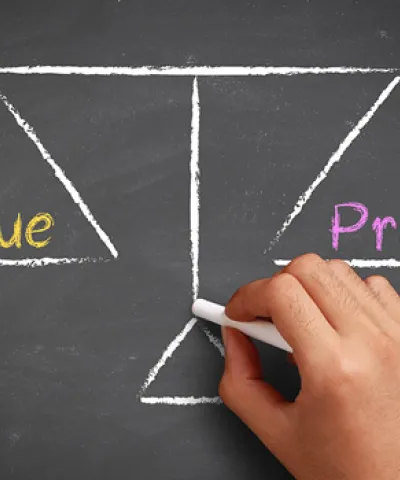A successful pricing strategy produces consistent, reliable profits and customer satisfaction. Businesses that aim for reliable results often explore a target pricing strategy. But what is target pricing and what are its benefits and drawbacks? And is it really that reliable?
What is a target pricing strategy?
The target pricing method determines pricing based on a target profit margin. It is based on the costs of producing and delivering your product or service and what customers will pay for it. You first decide how much profit you need to make then set the price based on that.
The set price meets two key requirements:
- It produces a reasonable profit for your business.
- Customers are willing to pay that price.
When you apply target pricing, you are methodically selecting the best price based on:
- Profit margin. The main purpose is to offer a product or service at a decided price. Target pricing controls costs so your business can continue to sell at the desired price point.
- Competition & customer behavior. Research your market to determine whether your product or service meets the needs of that market at your determined price point. Find out whether customers will buy your product or service at the desired price point.
How target pricing works?
Different companies have different strategies for maintaining a target price. To pursue a target pricing strategy, you follow several steps that look roughly like this:
- Market research. The goal of target pricing market is to determine who might buy your products and what they’re willing to pay.
- Determine your costs. How much will it cost your business to offer customers what they’re coming to you for?
- Determine target profit. How much profit must you make from each sale?
- Target price calculation. Add your desired profit to the cost of producing what goes into each sale. Your costs + your desired profit = your target price.
- Check the competition. If your competitors are selling similar products or services for more than your target price, you may have a strong opportunity.
- Adjust as necessary. Your target price may become obsolete. If it becomes too high or low compared to the rest of your market, you will need to readjust. Change your price to deliver what your customers need, at a price they are willing to pay.
In short, you set a price and adjust it based on what your customers want, what your competitors offer them, and what you need to make your desired profit.
Why choose target pricing?
Target pricing is simple and easy to implement and maintain. This pricing strategy provides a simple focus on covering costs and generating a specific profit. While it requires some research to implement and maintain, it is relatively low effort.
The Drawbacks of Target Pricing
The simplicity and robustness of target pricing make it an attractive option for many businesses. But target pricing often falls short when you compare it against more sophisticated strategies.
- Restricted profits. While it’s simple, target pricing is not the strategy that will maximize your profits. You can earn more profit by adopting a pricing strategy that doesn’t focus so heavily on cost-plus.
- Sensitive to market changes. When production costs rise due to factors like inflation, increased raw material prices, or changes in labor costs, it directly affects your product’s profit margins. If the target price is already set based on a specific profit margin, any increase in costs will reduce the actual profit you achieve.
- Getting out-competed. In a market that quickly becomes more competitive, your product or service may become difficult to maintain without cutting costs. Focusing on value-based pricing and other strategies better enables you to adapt and compete.
Target Pricing Alternatives
We often advise more sophisticated pricing strategies to meet the needs of changing market conditions. We recommend that you take the time to consider the benefits of alternatives to target pricing before deciding.
Target pricing alternatives can help you increase your profits and offer better value to your customers. You can achieve these results by shifting the focus of your pricing strategy in the following ways.
Value-Based Pricing
Value-based pricing is a strategy that emphasizes the value that customers perceive. It’s a more complex pricing model than target pricing. But it enables some businesses to set a higher price than their competitors for similar products.
You can determine a value-based price by focusing on the aspects that customers value more. Research for value-based pricing relies more heavily on customer feedback. Common factors that are included in value-based pricing include:
- Higher quality guarantees
- Greater convenience
- The feeling of luxury
- The feeling of community
- The unique solutions the product or service solves which alternatives do not
The price of your product or service is then set according to what customers are willing to pay. If customers perceive your product or service as being of higher value, you adjust the price accordingly.
The main advantage of value-based pricing is that it opens the potential for much higher profits. You can look to Apple as the main example of value-based pricing success.
The main downside of value-based pricing is the complexity and subjectivity. Getting your product or service accepted in the market with this pricing model is more of a challenge. We often guide our clients through this more complex process.
Read our full guide on Value-Based Pricing to learn more about implementing this strategy.
Segmentation
Segmentation in pricing strategy means applying different pricing strategies to different customer segments. We often recommend a segmented pricing strategy to make up for the diversity of many business’s customer bases.
Research will often reveal that different customer groups perceive value differently. One customer may perceive value differently than another and thus be willing to pay a higher price.
Segmentation’s key advantage is its versatility. However, it requires a more complex approach and monitoring.
Optimizing Price Levels
Optimization of price levels entails:
- Conducting more thorough market research
- Analyzing customer behavior
- Testing different pricing strategies
- Adapting to what works better over time
We often advise companies to take this approach to strike a balance between profitability and customer satisfaction. In carrying out this strategy, you discover the price sensitivity of your customers.
Price Optimization & Management Systems
Price optimization and management systems are often used to define pricing processes. They can be used to control pricing changes in a way that is flexible and adaptable to the market.
The advantages of optimizing pricing include greater competitiveness and greater revenue. However, it’s complex to put in place and leaves more room for error.
At Simon-Kucher, we provide tailored and customized solutions based on the unique needs and challenges of each client. We work closely with your company to understand your specific market dynamics, competitive landscape, and business objectives, offering solutions that align with your goals.
Value Communication
Value communication means emphasizing the value that your product or service offers to customers. Customers are willing to pay more when they understand the unique value that you offer.
Getting this message across involves effective marketing and communication strategies. With the right approach, you can communicate immense value even from traditionally uninspiring products and services.
Dynamic Pricing
Dynamic markets demand dynamic pricing strategies. We recommend clients in dynamic markets adopt strategies where prices are adjusted based on:
- Real-time market conditions
- Demand fluctuations
- Other relevant factors
Dynamic pricing isn’t new, but it’s a rapidly developing pricing strategy. It offers flexibility by using real-time, specific data to set the best price to optimize revenue. Pricing factors include:
- Time of day
- Demand
- Customer behavior
- Inventory levels
- Seasonal demand changes
- Your existing business strategy
The challenge is that dynamic pricing models are among the most complex. You need to be careful to not over-rely on algorithms, sacrificing the human element of pricing strategy. For example, when Whitney Houston passed away, the iTunes Store’s pricing algorithm increased the price of her album from $4.99 to $7.99. Customers saw interpreted this as Apple taking advantage of a tragedy. Mistakes like this can do far more harm than good.
How can Simon-Kucher help?
Target pricing is a simple and robust pricing strategy. It cuts directly to the core of competitive pricing: stable profit margins and satisfied customers. This simplicity also produces its drawbacks, which include restricted revenues and a lack of competitiveness.
Simon-Kucher helps businesses implement more complex pricing strategies that can maximize profit and enable long-term growth. We also help businesses mitigate the risks of pricing strategies that they put in place. Explore alternatives to target pricing and learn more. Contact us today!





